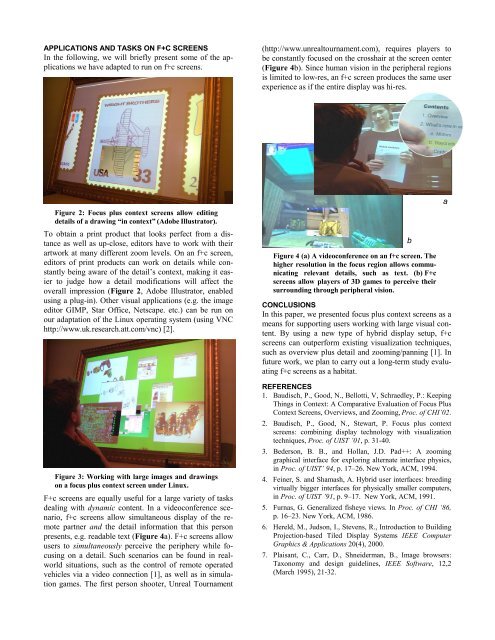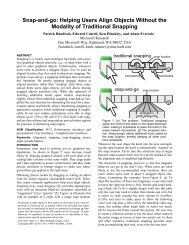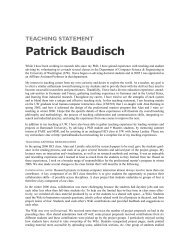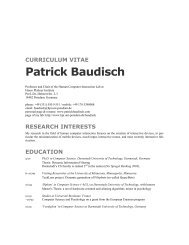Focus plus context screens: Displays for users ... - Patrick Baudisch
Focus plus context screens: Displays for users ... - Patrick Baudisch
Focus plus context screens: Displays for users ... - Patrick Baudisch
Create successful ePaper yourself
Turn your PDF publications into a flip-book with our unique Google optimized e-Paper software.
$33/,&$7,216 $1' 7$6.6 21 ) & 6&5((16<br />
In the following, we will briefly present some of the applications<br />
we have adapted to run on f+c <strong>screens</strong>.<br />
Figure 2: <strong>Focus</strong> <strong>plus</strong> <strong>context</strong> <strong>screens</strong> allow editing<br />
details of a drawing “in <strong>context</strong>” (Adobe Illustrator).<br />
To obtain a print product that looks perfect from a distance<br />
as well as up-close, editors have to work with their<br />
artwork at many different zoom levels. On an f+c screen,<br />
editors of print products can work on details while constantly<br />
being aware of the detail’s <strong>context</strong>, making it easier<br />
to judge how a detail modifications will affect the<br />
overall impression (Figure 2, Adobe Illustrator, enabled<br />
using a plug-in). Other visual applications (e.g. the image<br />
editor GIMP, Star Office, Netscape. etc.) can be run on<br />
our adaptation of the Linux operating system (using VNC<br />
http://www.uk.research.att.com/vnc) [2].<br />
Figure 3: Working with large images and drawings<br />
on a focus <strong>plus</strong> <strong>context</strong> screen under Linux.<br />
F+c <strong>screens</strong> are equally useful <strong>for</strong> a large variety of tasks<br />
dealing with dynamic content. In a videoconference scenario,<br />
f+c <strong>screens</strong> allow simultaneous display of the remote<br />
partner and the detail in<strong>for</strong>mation that this person<br />
presents, e.g. readable text (Figure 4a). F+c <strong>screens</strong> allow<br />
<strong>users</strong> to simultaneously perceive the periphery while focusing<br />
on a detail. Such scenarios can be found in realworld<br />
situations, such as the control of remote operated<br />
vehicles via a video connection [1], as well as in simulation<br />
games. The first person shooter, Unreal Tournament<br />
(http://www.unrealtournament.com), requires players to<br />
be constantly focused on the crosshair at the screen center<br />
(Figure 4b). Since human vision in the peripheral regions<br />
is limited to low-res, an f+c screen produces the same user<br />
experience as if the entire display was hi-res.<br />
Figure 4 (a) A videoconference on an f+c screen. The<br />
higher resolution in the focus region allows communicating<br />
relevant details, such as text. (b) F+c<br />
<strong>screens</strong> allow players of 3D games to perceive their<br />
surrounding through peripheral vision.<br />
&21&/86,216<br />
In this paper, we presented focus <strong>plus</strong> <strong>context</strong> <strong>screens</strong> as a<br />
means <strong>for</strong> supporting <strong>users</strong> working with large visual content.<br />
By using a new type of hybrid display setup, f+c<br />
<strong>screens</strong> can outper<strong>for</strong>m existing visualization techniques,<br />
such as overview <strong>plus</strong> detail and zooming/panning [1]. In<br />
future work, we plan to carry out a long-term study evaluating<br />
f+c <strong>screens</strong> as a habitat.<br />
5()(5(1&(6<br />
1. <strong>Baudisch</strong>, P., Good, N., Bellotti, V, Schraedley, P.: Keeping<br />
Things in Context: A Comparative Evaluation of <strong>Focus</strong> Plus<br />
Context Screens, Overviews, and Zooming, Proc. of CHI’02.<br />
2. <strong>Baudisch</strong>, P., Good, N., Stewart, P. <strong>Focus</strong> <strong>plus</strong> <strong>context</strong><br />
<strong>screens</strong>: combining display technology with visualization<br />
techniques, Proc. of UIST ’01, p. 31-40.<br />
3. Bederson, B. B., and Hollan, J.D. Pad++: A zooming<br />
graphical interface <strong>for</strong> exploring alternate interface physics,<br />
in Proc. of UIST’ 94, p. 17–26. New York, ACM, 1994.<br />
4. Feiner, S. and Shamash, A. Hybrid user interfaces: breeding<br />
virtually bigger interfaces <strong>for</strong> physically smaller computers,<br />
in Proc. of UIST ’91, p. 9–17. New York, ACM, 1991.<br />
5. Furnas, G. Generalized fisheye views. In Proc. of CHI ‘86,<br />
p. 16–23. New York, ACM, 1986.<br />
6. Hereld, M., Judson, I., Stevens, R., Introduction to Building<br />
Projection-based Tiled Display Systems IEEE Computer<br />
Graphics & Applications 20(4), 2000.<br />
7. Plaisant, C., Carr, D., Shneiderman, B., Image browsers:<br />
Taxonomy and design guidelines, IEEE Software, 12,2<br />
(March 1995), 21-32.<br />
b<br />
a






